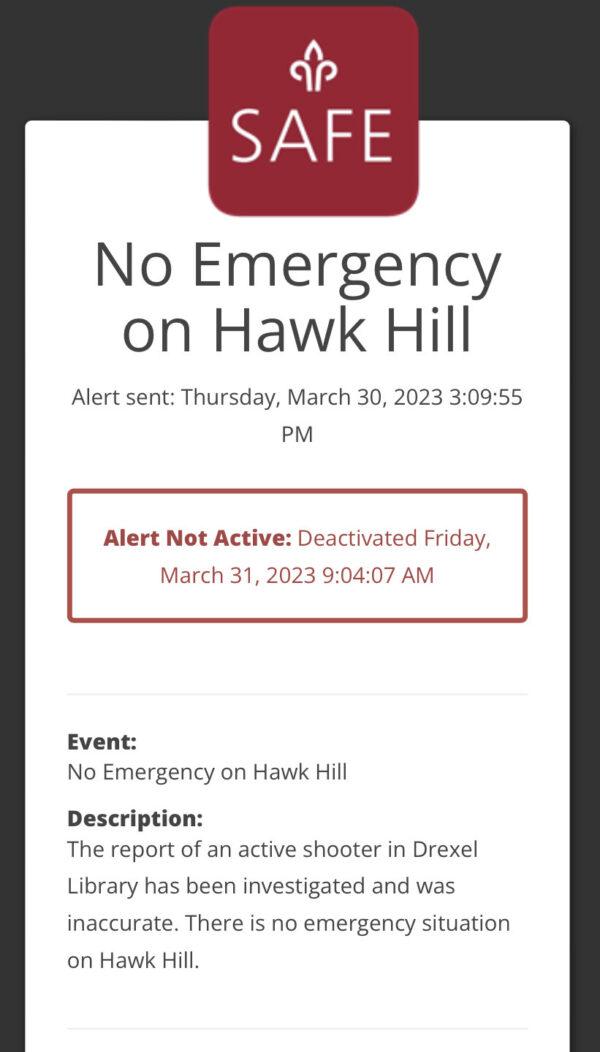At 2:42 p.m. on March 30, the Office of Public Safety & Security received a call from off campus with a second-hand report regarding a potential active shooter in the Francis A. Drexel Library.
“The supervisor, the public safety administrator and two uniformed police officers assigned to the SJU detail immediately headed to the library,” wrote Kevin Gfeller, assistant director of public relations for the Office of Marketing & Communications, in response to written questions from The Hawk. “The SJU Public Safety supervisor accompanied police into the library.”
About 25 members of the Philadelphia Police Department and the Lower Merion Police Department ended up on the scene, Gfeller said. The 14 St. Joe’s public safety officers on shift at that time were asked by police to stay clear of the area and not enter the library, he added.
The sight of those officers surrounding the library — and no information broadcast on the SJU Safe Emergency Notification System — set off a wave of panic on campus.
Juliana Hackett ’23, watching the scene from a classroom window in Post Hall, texted her roommates: “Um like 20 cops just pulled up to the lib running is everyone good?”
Emma Gugliemini ’23, hiding in one of the library bathrooms, texted her roommates: “Everyone started screaming and running, so we ran to the bathroom.”
As confusion spread among campus community members, students and professors in nearby buildings barricaded themselves in classrooms. Those in the library hid, or ran, unsure what was happening. Others gathered outside the library, worried, crying, watching people run from the library as a police officer patrolled the roof.
“I just heard, ‘Get your hands up, put your hands up, get on the ground,’” said Carter Geer ’25, who was in the library when police arrived.
Geer said he was in shock after police escorted him out of the library.
“I couldn’t figure out how to go on with the rest of my day,” Geer said.
Jill Amitrani-Welsh, associate director of the Faith-Justice Institute, was meeting with a student in her office in Post Learning Commons at the time of the incident.
“The student noticed the police officers approaching the building, at which point their stance was pretty clear that it wasn’t a medical emergency, but some other crisis,” Amitrani-Welsh said.
Amitrani-Welsh said she asked the student to shut the door and hide under the desk with her, which they continued to do until the police officers entered the suite, identified themselves as police officers and told them to exit the building.
“We’ve gone through the trainings as employees,” Amitrani-Welsh said. “It was in that moment that those trainings kicked in, and I was able to, as much as possible, stay calm and hopefully make some great decisions in an unpredictable situation.”
Once they were out of the library, Amitrani-Welsh said she and the student ran for safety.
At 3:09 p.m., an alert appeared on SJU Safe system: “No emergency on Hawk Hill. The report of an active shooter in Drexel Library has been investigated and was inaccurate. There is no emergency situation on Hawk Hill.”
“Although police knew very quickly upon arrival that this was a false report, additional calls were coming in from others on campus and police needed to complete their on-site procedures,” wrote Gfeller.
But by then, many members of the university community were traumatized. Students went back to their residence halls shaken, not wanting to be alone for the rest of the evening. Others called out of work on campus or skipped their evening classes. Even the next day, some were reluctant to return to campus, especially to the library.
The University Student Senate delivered a statement at 6:30 p.m. on the night of the incident, expressing their gratitude to the Philadelphia Police Department and the Office of Public Safety & Security for responding to the incident in a timely manner.
But the statement also criticized the lack of official communication.
“By the time that an announcement from Public Safety was released to the student body on the SJU Safe App at 3:09 pm EST, it had already been more than 20 minutes since students in the library were told to take cover,” the statement read. “Apart from communication with those in the affected location, students had no guidance as to proper procedure during this interval. Additionally, multiple students reported that they were not given information after calling Public Safety during this time.”
In an email to the university community sent the afternoon of March 31, Ross Radish, J.D., interim vice president of Student Life, admitted there was a “gap in our protocol” regarding a false active shooter report on Hawk Hill.
“That is unacceptable, and we are taking steps to eliminate that gap,” Radish said.
Both Radish and Gfeller said one of those steps is a thorough review of what happened.
“We have time scheduled [this] week to review the Emergency Notification System (ENS) and provide any additional training necessary. We will also be conducting a wide test of the ENS. An active shooter drill was already scheduled for this summer and we are considering how we can add the additional scenario of managing false reports,” wrote Gfeller.
Members of the St. Joe’s community seeking support are encouraged to contact the following resources:
Counseling and Psychological Services (CAPS), 610-660-1090
Campus Ministry, 610-660-1030
The Office of Student Outreach & Support, 610-660-1149
The Jesuit community, 610-660-1400
Employee Assistance Program, 866-799-2728















































